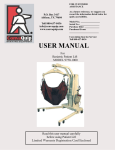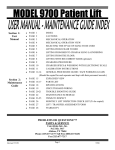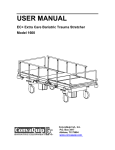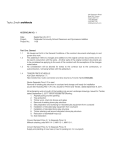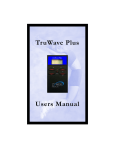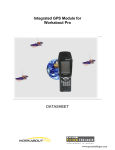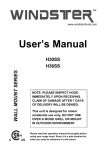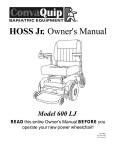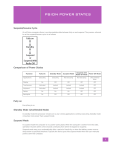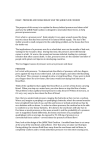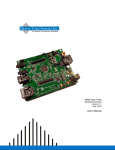Download 9750 Owners Manual.cdr
Transcript
Bariatric Patient Lift CQ-9750 USER MANUAL PAGE 1 INDEX PAGE 2 OPERATION AND LOCATION REFERENCE PAGE 3 REFERENCE PICTURE OF MECHANICAL OPERATION PAGE 4 SELECTING THE STYLE OF SLING TO BE USED LIFTING FROM CHAIR TO BED PAGE 5 LIFTING FROM BED TO CHAIR LIFTING FROM THE FLOOR PAGE 6 LIFTING WITH RECUMBENT BARS PAGE 7 WEIGHING WITH ELECTRONIC SCALE CHARGING PROCEDURE PAGE 8 SERIES 9750 SPEC SHEET PAGE 9 TROUBLE SHOOTING GUIDE PAGE 10 TROUBLE SHOOTING GUIDE (CONT.) PAGE 11 ROUTINE MAINTENANCE PAGE 12 WARRANTY PAGE 13-15 GENERAL PROCEDURE GUIDE Page 1 MECHANICAL OPERATION LOCATION SERIES 9000 (CQ-9750 Operation Corresponds with the View on Page 3) 1. This lift is powered by a 24VDC removable battery pack located at the back of the lift. The battery fits either way in the lift and charger receptacle to make it easy to remove and replace the battery. 2. The lift has a built-in battery indicator which illuminates when the battery is about 60% used up. This would be the best time to replace with the battery that is full in the charger. 3. Once the battery is inserted into the charging receptacle, the charge light on the charging unit comes on. Make sure this yellow light comes on to assure your battery is charging. Once the battery is fully charged, the light will turn green. The charger is fully automatic and will quit charging when the battery reaches a full charge. You will not damage the battery or charger if left plugged in all the time. 4. The lift is operated by switches located at the tips of the handles. This allows proper ergonomics by keeping the hands on the handles while operating the lift and maneuvering it at the same time. 5. The optional hand control gives a second source to operate the lift. This allows the operator to be next to the person being transferred and operate the lift at the same time. It also aids as a backup source to operate the lift. 6. If for any reason the lift would stop in mid-travel, the first thing to check is the circuit breaker located on the battery receptacle. If the breaker has popped out, simply press it back in and try lifting. If the problem is not the breaker, and you cannot lower the patient/resident by the switch on the handle or the remote control, you must use the safety override manually. 7. To operate the lift manually, insert the manual override speed wrench that is located at the back of the lift. Insert the speed wrench through the access hole at the back of the lift indicated by the sticker stating “Manual Override”. Turn the wrench in the direction of the arrow on the sticker to lower the lift manually. Depending on the distance needed to travel, this could take several minutes to lower. A faster option would be to use a 1/4” socket driver and an electric drill inserted in the same location as the manual override speed wrench supplied. 8. The leg adjuster opens and closes the legs of the lift. By pushing forward on the handle, maneuver the handle around the stopper plate until the handle snaps into the fully extended position. This enables the lift to be narrowed to go through doorways and widened to go around a wheelchair or lounge chair. 9. The brakes are located on the rear wheels. Press the tab with your foot to lock the wheel and the pivot. Press the tab upward to release the brakes. Page 2 MECHANICAL OPERATION Informative Graphic Forthcoming. Page 3 SELECTING THE STYLE OF SLING TO BE USED The first step is to select the Style of sling to be used. The most common sling is the divided leg sling. The person must have two full legs in order for you to use the divided leg sling on them. This sling is designed to be removed from the Person after they have been transferred into their wheelchair. This way, they do not have to sit on the sling throughout the time they are sitting in their chair. If you find it difficult to remove a divided leg sling from behind a person while they are seated in a wheelchair, you may choose to leave it behind them. Be sure to observe the correct position of the sling before you lift that person. The sling may have moved. If a person has discomforts while you use the divided leg sling on them, an option would be the hammock sling. If you are lifting a single or bilateral amputee, you must always use a hammock sling. The hammock sling comes with or without the commode hole. The second step is to determine the proper Size. It’s simple. Lay a sling across the persons chest. If it’s the proper size sling, you will note 7-8 inches of extra material extended past the side of each arm. If you observe little or no fabric extended past the arms, you must upgrade to a larger sling. If you observe more than 8 inches of fabric past each arm, downgrade to a smaller sling. All styles have a color coded border to easily indicate the size of sling: (purple for Small, raspberry for Medium, teal for Large, and black for X-Large). The loops on the straps are color coded for positioning the sling to the desired location. Changing the orientation of these loops will change the angle of the Person being transferred. This comes in handy for charting the colors that would work best for each individual. All sling styles come with built-in positioning handles on the back of the sling. These always face out and are used to position a Person back in a chair. LIFTING FROM CHAIR TO BED To apply the divided leg sling on someone sitting in a wheelchair, first lean the person slightly forward to get clearance between the back of the person and the back of the wheelchair. Keeping the sling from twisting, work the sling along the crevice between the legs and the chair. Make sure the sling is all the way down and that there is no gap behind the person. If the sling is not all the way down, it will not come under the leg very easily. Work the sling along side the legs, getting as much material going toward the front of the chair as possible. Raise the leg and pull the material through, trying to prevent any wrinkles. Crisscross the inside flaps with the main loops, then tread the strap with the color-coded loops through the main loop down to the stopper and do the same thing on the other side. Crisscrossing the inside flaps will keep the legs tight together for a more comfortable and dignified transfer. If during the transfer it is required for the person’s legs to relax open, you can hook it up without crisscrossing the inside flaps. This will allow the legs to relax open. Now that the sling is positioned, bring the lift towards the person, open the legs of the lift to the wide position, lower the hanger until the desired colored loops can be hooked on the hanger. It doesn’t matter if the front or back is hooked up first. Now, push the up button on the handle or use the remote control to raise the person high enough to clear the bed. Position the lift so that the person will be lowered to the proper position in the bed. Once there is plenty of slack in the straps, remove the loops from the hanger and pull the lift out of the way. Un-thread the straps from the main loops. Roll the person on their side and fold the sling, then roll to the other side and remove the sling. Page 4 LIFTING FROM BED TO CHAIR When transferring from bed to chair, just reverse the steps we just did. Roll the person to their side and fold the sling. Align the bottom of the back of the sling by the tailbone. Roll the person to their side and pull the rest of the sling through, straightening any wrinkles. Bring material under the legs the same way as if they were in the chair. Crisscross the inside flaps and thread the straps through the main loops. Bring the lift in adjusting the base to the desired position and lower hanger near the center of the person being transferred. It is recommended to keep the lift in the widest position at all times when transferring a person that is uncooperative or combative. Bend the knees and hook up the color-coded loops that were previously used to bring them to a sitting position. Press the button to raise the lift and make sure the material under the leg stays straight towards the knee, keeping out as many wrinkles as possible. Note: If the base is in the narrow position, adjust it to the widest position once you are clear from the bed and always before turning. Once we are over the chair, lower and guide the person by the builtin handles on the sling to bring them back far into the chair. To remove the sling, reverse the step. Unthread the straps from the main loops, raise the legs, and pull the material aside. Now, lean the person forward and pull sling clear. LIFTING FROM THE FLOOR To transfer from the floor, apply the sling with the same procedure as if they were in bed. If the person is on the floor as a result of a fall, no transfer should be attempted until it is determined that there are no injuries. Once the sling is positioned under the person as if they were lying in a bed, bring the lift up to the person being transferred from either the head or legs. If the lift is brought in by the head, apply a pillow between the head and the base of the lift. Lower the lift to the lowest position and hook up the front two straps to the hanger. Push the lift up as far as possible, then lock the brakes. Now, hook up the back two straps by bending the knees and applying the loops to the hanger. All the models of slings come with straps long enough to transfer from the floor. Note that we are using the sling with a built-in head support. If you are using a sling without a head support, you will need to support the head with your hands. When bringing the lift in by the legs, lift the legs onto the base again, cushioning with some pillows. Page 5 RECUMBENT BAR INSTRUCTIONS The R-bars were developed in response to several requests from customers to develop a system that will transport hip patients. The system will equally lift patients whose bodies are rigid. Previous to the R-bar system, nurses had no choice but to lift their patients manually, thereby placing themselves and patients at risk. Caution: Be sure to consult with the patient’s health care provider for proper patient positioning and transport. The R-bar system is designed to be used on CQ-9750 Lift only! Instructions: 1. Assess the Patient: Consult with the patient’s nurse. 2. Prepare the Model CQ-9750 Lift: Remove the R-bars from the bag. Attach the R-bars to the Jhooks on the lift. Double check the connections. Observe the black nylon loops. If frayed, cease activity and order new loops. Be sure to hang the R-bars directly under each moving hanger bar from the lift. You want the R-bars to mirror image the movement of the existing hanger bars. Do not attach the R-bars perpendicular. 3. Safety: Observe the R-bar sling you will be using. Check the fabric for tears, holes, and frays. If damaged, replace with a new sling. 4. Place the Abductor Pillow: Place the pillow between the groin and the knees. Note a white label that says “ConvaQuip”. You should be able to read that label as it is placed properly between the legs. 5. Place the Sling: Rest the sling beside the patient. Log roll the patient to one side. Carefully slide the sling underneath the patient. Be sure the bottom of the sling will rest at knee level. Roll the patient back and pull the remaining material out until you see that the patient will be directly in the middle of the sling. 6. Lift the Patient: Open the legs of the lift. Place the R-bars directly over the patient. Use the patient’s belly button as a centering point. Lower the lift low enough to provide ease of sling hook-up. Double check your connections. Adjust the head support. Tell the patient you are about to lift them, then lift. Lift the patient high enough to clear the bed and transport to the nearest recliner. Center the patient over the recliner and lower the patient. DO NOT MANIPULATE THE LIFT BY PULLING ON THE PATIENT! Remove the abductor pillow and leave the sling behind the patient. Before you lift the patient from the recliner to transport back to bed, check to see that the sling is in the correct lifting position. If not, reposition the sling. Open the legs on the lift. Apply the abductor pillow. Lift, Transport, and Lower the patient into bed. Unhook the sling and move the lift aside. Remove the sling from under the patient. Observe the sling for contaminants. If soiled, launder per ConvaQuip instructions located on the sling. Page 6 WEIGHING WITH ELECTRONIC SCALE The electronic digital scale allows the person to be weighed during a transfer. Press the “ON/ZERO” button to turn on the scale. Make sure that “LOW BAT” did not appear on the screen, if so, replace the four “AA” batteries located on the side of the scale. The scale will take about 5 seconds to zero itself. Place the desired sling onto the hanger, making sure it is not touching the ground, and press the “ON/ZERO” button. This will place the weight of the sling into memory and will automatically minus out the weight of the sling from the reading. This reading will always stay in memory, even if the scale is shut off, until you run this procedure again. Now with the scale still on, remove the sling and place it beneath the person being weighed. Select pounds or kilograms by pressing and holding the units button to toggle back and forth. Lift the person clear of the chair or bed. Once the reading is steady, the scale will lock on the reading to make it easier to read if the person will not remain steady. The scale runs on four “AA” batteries. The scale has a built-in battery indicator that will warn you when the batteries are getting low. The scale will automatically shut off by itself if left untouched over 2 minutes. To manually shut off the scale, simply press and hold the “OFF” button until the screen goes blank. The optional Litter Attachment or Recumbent Bars can be used to weigh someone who is bedridden and must be lifted in a horizontal position. The scale will zero out the weight of the litter or recumbent bars to resemble the most accurate weight. CHARGING PROCEDURE 1. The lift has a battery indicator light located on the receptacle that will flash when the battery is low. This is the best time to exchange the battery with one that is fully charged at the charger. 2. Keep the charging receptacle on a counter or flat surface near an outlet where the suction cups will have good contact. 3. With the charger plugged into the outlet, the battery can be inserted either way into the charging receptacle. Insert the battery from the top, making sure the yellow light comes on to indicate contact. 4. When the green light on the charger has lit, the batter is fully charged and will shut off automatically. It will not overcharge the battery. *The charger will not be damaged if lift in the wall at all times *The charger will get warm during its charge cycle Page 7 CQ-9750 Bariatric Patient Lift Spec Sheet Informative Graphic Forthcoming Item No.Part No. 1 2 3 4 5 6 7 8 9 10 11 12 13 14 15 36 Base Assembly Complete Front Leg Assembly Pin Front Leg Assembly (Left) Pin Washer Top Cap Assy Mast Spacer Cap 1000 lb - L mast 1000 lb - R mast Base Cover Ver III- 1 Base Cover Ver III- 2 1000 lb Lifting Assembly 1000 lb Power Box Assembly 5 in Revvo 5 in Revvo Qty. 1 1 2 1 2 2 1 1 1 1 1 1 1 4 2 Item No.Part No. 16 17 18 19 20 21 22 23 24 25 26 27 28 29 Front Mast Cover Rear Mast Cover Side Mast Bracket Assy R Side Mast Bracket Assy L Handle Bar Assy HDK Beam Hander Mount Shaft HDK Hander Complete HDK Adj Handle Assembly Adjuster Mount Assembly HDK Leg Adjuster Rod Assy R HDK Leg Adjuster Rod Assy L HDK 24V Battery HDK Leg Cover 10047-2 Square Remote Assy Qty. 1 1 1 1 1 1 1 1 1 1 1 1 2 1 Page 8 BARIATRIC PATIENT LIFT Model CQ-9750 TROUBLESHOOTING and MAINTENANCE GUIDE CAUSE PROBLEM SOLUTION I. LIFT 1. Lift won’t go up 1. 2. 3. 4. Bad lift control switch Dead battery Hand control is broken Actuator not working 6. Circuit Breaker popped 1. Remove and replace 2. Switch batteries 3. Send in hand control for repair or order new parts 4. Replace motor 5. Make sure battery pack is making contact with terminals in the receiver box 6. Push in Circuit Breaker 1. Not enough grease on actuator 2. Loud ticking noise when lift goes up and down 1. Put white lithium grease on the upper and lower part of the actuator 2. Replace actuator nut 3. Faulty or worn out actuator 3. Replace actuator 1. Batteries are worn out or circuit board is bad 2. Batteries are not being charged when the RED charge battery light comes On 1. Order new batteries or order new circuit board 2. Order new batteries; also make sure that you charge the batteries when the RED light comes on 1. Fuse is blown in the transformer 2. Electrical outlet may not be Operational 1. Order a new transformer 5. Battery is not making connection II. ACTUATOR 1. Actuator makes noise III. BATTERY PACK 1. Charge battery light stays on constantly 2. Batteries wearing out too Quickly IV. BATTERY CHARGER 1. Battery charger lights do not come on when plugged in 2. Use different outlet Page 9 BARIATRIC PATIENT LIFT Model 9750 TROUBLESHOOTING and MAINTENANCE GUIDE (CONTINUED) PROBLEM CAUSE SOLUTION I. SCALE 1. Inaccurate weights 1. Not zeroing out scale properly 2. “Lbs” to “Kg” switch is in the wrong setting 3. Batteries in scale are low 4. Person in lift is moving excessively while taking weight 5. System is out of Calibration 1. Zero scale according to instructions 2. Switch to desired setting 3. Replace the four “AA” batteries in scale 4. Make sure the patient is hanging evenly under the hanger and there is minimumal movement 5. Calibrate the scale following the calibration Instructions 2. Display is erratic 1. Lift battery is low 1. Replace the lift battery 3. Display screen is blank 1. Power to scale is not turned on 2. Lift battery is dead 3. Scale is damaged 1. Turn scale on 2. Replace the lift battery 3. Call tech suppport for Instructions 4. Scale reads 9.0L 1. The wiring harness connecting the load cell to the display box has either been damaged or disconnected 1. Check entire black wire connecting the load cell to the display box for a cut or break Note: If you find a break in the wiring harness, you will need to solder the wires back together and tape them individually. Page 10 ROUTINE MAINTENANCE Every Day Periodically * After each person you lift, you should check the sling, and wash if needed; refer to the ConvaQuip laundering Instructions located on the sling label. * Grease actuator every six months. * Check the movement of the lift; remove hair from the casters if needed. * Check leg covers; if cracked, replace with new. * Check all vinyl covers; if worn, replace with new. * Check all external fittings; tighten where needed. * Check the condition of all slings; if you are in doubt of its operational ability to safely lift a person, then discard the sling and order a new sling. * Check the lift; if the “RED” light is on, then charge the batteries. Periodic Testing * General Lift Condition: A general visual inspection of the external parts and all functions should be carried out to ensure no adverse damage has occurred. If any doubt, withdraw the equipment from use and call the ConvaQuip Service Dept at (800) 637-8436. * Keep your ConvaQuip lift clean by wiping it down with a damp cloth; use a mild detergent if needed. NOTE: Do not use a petroleum based solvent on paint, stickers, or plastic. Page 11 WARRANTY 1 YEAR LIMITED WARRANTY ON ALL PARTS ONLY UNDER CONDITIONS OF NORMAL AND INTENDED USE. 10 YEAR WARRANTY ON THE MAIN STRUCTURE OF THE LIFT. MISUSE, DAMAGE OR ALTERATION OF BODY LIFT OR ANY OF ITS PARTS, VOIDS THE WARRANTY. NO OTHER WARRANTIES WRITTEN, VERBAL, IMPLIED OR OTHER THAN LISTED HERE WILL BE HONORED. Page 12 MECHANICAL FULL BODY LIFTS GENERAL PROCEDURE GUIDE Thank you for selecting the ConvaQuip Patient Lift. The purpose of these operating instructions is to introduce the authorized user/operator in using and working with this device safely, and to conduct routine preventative maintenance procedures on the device. For this goal to be achieved, it is essential that the authorized user/operator carefully read this manual, understand, and practice the precautionary measures recommended in it. Please have anyone who will be operating this lift read this manual. This form is intended as a guide to help you develop a procedure sheet that will fit your specific application in your facility. Staff Name: ____________________________________ Date: ____________________________________ Checked Off By: ____________________________________ General Preparation: Yes No 1. Identify the resident or patient. 2. Explain what you are going to do. 3. Wash hands. 4. Get supplies ready: sling, wheelchair, blanket or lap robe. 5. Get help from experienced team member for this procedure. 6. Have assistant stand on opposite side of bed to assist with transfer. 7. Provide privacy. Pull curtain all around the bed. 1. Position wheelchair at foot of bed. 2. Adjust bed to working level. 3. Make sure battery indicator does not indicate low battery. (If so, replace.) General Procedure: No Yes Page 13 MECHANICAL FULL BODY LIFTS GENERAL PROCEDURE GUIDE Yes (Continued) No 4. a.) Examine lift sling for any damage: tears, frays, or weak areas. b.) Make sure the correct size sling is to be applied. c.) If weighing resident or patient, hang the sling on the hanger hooks, press the ON button. 5. Lower side rails. 6. Roll resident or patient to one side and place sling, folded halfway under resident or patient. Top of sling should be approximately at shoulder blade area. Bottom of sling should be approximately near the tail bone. 7. Roll resident or patient to other side and pull rolled half of sling through. Smooth sling and check correct placement. 8. Roll resident or patient onto center of sling. Pull padded legs on sling along each side and wrap inside thigh areas close to groin area. Crisscross straps through the holes before hooking to the lift. 9. Raise head of bed slightly. 10. Position lift over bed and instruct assistant to help guide lift into proper position. 11. Check that base legs of lift are in wide position where applicable. If base position must remain in narrow position, make sure the lift area between bed and chair are clear of any obstacles. Widen once clear from bed. 12. Attach straps on sling to lift. Remember that the straps at the thigh area must be crisscrossed at the hanger before lifting. 13. Tell assistant to guide resident as you begin to lift them from the bed using “up” button on hand control or “up” button at handle grips. Once there is slight tension on the straps, check to make sure all four loops are still on the hooks before lifting. 14. Lift resident or patient until buttocks have cleared the bed. Give reassurance to allay fears. If weighing, steady resident or patient and look at the reading on the scale. 15. Tell assistant to steady the resident or patient in lift and guide to position over wheelchair, trolley, tub lift, etc. CAUTION: Push and turn the lift from the handles only. Pushing on the top of the beam or on the resident or patient could jeopardize the lift’s stability. 16. Lock wheelchair brakes. 17. Instruct assistant to stand behind wheelchair and place hands in positioning straps on both sides of sling. While the resident or patient is coming down, pull the handles back to position the resident or patient in an upright position. Page 14 MECHANICAL FULL BODY LIFTS GENERAL PROCEDURE GUIDE Yes (Continued) No 18. Disconnect all straps from the hanger and remove sling by raising legs and pulling along sides. Ask resident or patient to lean forward to remove for back and hip area. 19. Move lift away and adjust for comfort. Apply safety belt if ordered. Position feet on foot pedals. 20. Cover lap with blanket and leave call light within reach. 21. Wash hands. Report reaction and overall tolerance to team leader. Page 15















